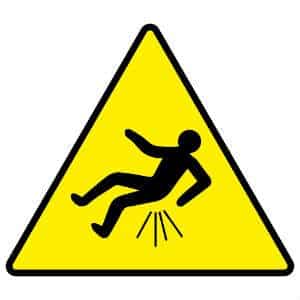After suffering injuries caused by a slip and fall, it can be hard to get back on your feet. You likely have questions, such as:
The New York City construction site slip, trip, and fall lawyers at Banville Law have helped numerous injured workers just like you. Schedule your free consultation by filling out the contact form.
According to the Occupational Safety & Health Administration (OSHA), “slips, trips, and falls constitute the majority of general industry accidents.” For construction workers in New York, this is particularly true. Falls are the most common cause of death in the construction industry itself, accounting for 39.9% of all fatal construction accidents in the year 2014.
It’s easy to see why. Look around any job site in New York City and you’ll see numerous slip, trip, and fall hazards. From open holes in flooring to workers overreaching on ladders, construction workers in New York City must routinely access elevated positions, risking their lives to construct the buildings and structures that make our city possible. Accidents occur with concerning frequency, often leaving workers in serious medical conditions, such as the Brooklyn worker who fell 15 feet into a trench in April of 2016. These types of accidents not only accrue large medical bills but cause tremendous amounts of pain and suffering for the victim and their family.
Were you injured in a construction site slip, trip, and fall accident? As an employee in New York City, you are entitled to a Workers Compensation claim. Workers Comp is intended to reimburse injured workers for medical expenses lost wages – and nothing else. In many cases, a workers' compensation insurance company’s settlement offer will be insufficient, and you could spend years making the rest up out of pocket.
But there’s another way. If your slip and fall accident was caused by unaddressed hazards on the worksite, defective tools or equipment, or another condition that could have been prevented, you may be able to file a construction accident lawsuit. The New York City construction site slip, trip, and fall lawyers at Banville Law have helped numerous injured workers just like you. Over decades of successful legal representation, we’ve secured high-value settlements and verdicts – allowing New York’s accident victims a peaceful, secure recovery. Now it’s your turn.

Most construction site slip or trip, and fall accidents are caused by one (or a combination) of the following problems:
Although both OSHA and New York State have established rigorous safety regulations for construction sites across New York City, slip, trip, and fall accidents continue to occur at an alarming rate. OSHA reports that the most frequently violated construction site regulations are:
Employers in New York City must provide their workers with adequate safety equipment, including that specifically designed to prevent falls from heights. All employees working at heights must be provided, and adequately trained in the use of: safety nets, harnesses, guardrails, and warning lines.
You’ve fallen. You’re hurt and missing days at work. Now it’s time to get up. And while your employer and New York’s Workers Compensation system may want you to settle, the dedicated personal injury attorneys at Banville Law have a different plan.
We want to see you recover and re-enter the workforce stronger than ever. Filing a personal injury lawsuit will not only put money in your pocket, it will hold those responsible for your accident accountable. Contact Banville Law for a free consultation. It’s time to stand again.
Visit our next page on building collapses on construction sites: https://banvillelaw.com/construction-injury/building-collapse/